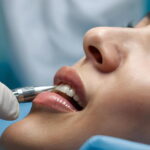Did you know that more than 1 in 4 adults in the U.S. have untreated dental cavities? That’s about a quarter of the entire population in the country. And one of the most common reasons for this is an inconsistent oral care routine. Most people, even adults, forego the simple practice of brushing at least twice daily, leaving their teeth vulnerable to bacteria.
Understandably, today’s fast-paced modern life can lead to people neglecting their health. But keeping the detrimental consequences of this neglectful behavior in mind, change is necessary. Poor dental health, for instance, has been known to lead to more serious health issues, including heart disease, diabetes, stroke, and in some cases, long-lasting conditions like Alzheimer’s.
So, when simple steps like looking after your teeth and gums can help avoid these issues, why not pay attention to them? Here are certain steps you can take to create a routine and stick to it while also making sure that it is effective:
1. Start With an Initial Dental Assessment
You can never really know the exact condition of your oral health unless you visit a dentist for a proper assessment. A thorough examination can reveal issues that you may never know existed. Getting yourself checked is the best place to start when trying to overhaul your oral health routine because it gives you a solid baseline to work up from.
You can visit a dentist or orthodontist depending on the type of issue that you may have with your teeth. These professionals are not only able to check your teeth and gums thoroughly but are also able to advise on the best steps moving forward. For instance, if you want to get braces, retainers, or your teeth aligned, an orthodontist can prove valuable in this regard. Based on individual assessment, orthodontists can advise which treatment will resolve your dental health problems. So, look up effective orthodontic treatment near me and determine which one is more suitable for you.
2. Create A Routine
Once you’ve been to the dentist and learned what may or may not be wrong with your teeth, it is best not to completely ignore or become neglectful of the suggestions. Ensure to follow through on it. Start by pushing yourself to build that routine of brushing at least twice daily that you were taught from a young age.
You may have a million reasons to skip brushing, especially at night, but it is important to put every one of them aside. Likewise, if your dentist has recommended flossing before bedtime, don’t forget to do so every night.
However, if flossing is too time-consuming for you, this dentist who does Invisalign in Williamsburg VA recommends using interdental brushes instead.
3. Brush After Consuming Acidic Foods
Most people have a habit of starting their day with a glass of orange juice. Although that is perfectly healthy, what’s not so good is going to brush your teeth immediately after. Beverages and foods with a low pH, including acidic foods, soften the enamel of your teeth temporarily. So, if you brush immediately after that orange juice, you may remove some of the enamel on your teeth, leaving them vulnerable to plaque and decay.
It is ideal to wait at least 30 to 60 minutes before brushing once you have consumed citric or acidic foods. And this includes wine, fruits, or juices considered citric. This step also applies to carbonated beverages and wine because of the low pH measure. A recent study has shown that people who wait before they brush can reduce wear and tear on their teeth compared to those who brush immediately after consuming acidic foods.
4. Use Brushes with Soft Bristles
It is common knowledge that you should replace your toothbrush at least every two or three months. You may also have to do it sooner if the bristles are damaged. However, if you have a brush with medium or hard bristles, it may be time to change it. You may have your reasons for using this toothbrush, but the reality is that it damages your teeth considerably.
Hard bristle toothbrushes can make your teeth feel cleaner, but they are abrasive and detrimental to the enamel on your teeth. So, get the softer one instead of using a hard toothbrush. And to get the same results as you did with the harder brush, tilt your brush at a 45-degree angle and then use circular motions to go all over the oral cavity.
Because every little crevice in your molars increases their susceptibility to tooth decay and cavities, brushing from the back of your oral cavity may help you clean those challenging areas more effectively. Starting in the back is advisable because that is where most particles get stuck, eventually leading to cavities and tooth decay.
Giving the back of your oral cavity the time and care it needs by starting your brushing regimen in the back is a smart idea, at least occasionally. So, always begin brushing your teeth in the upper right corner of the back. Also, it is important that you commonly use the same approach so that you know that you won’t overlook any locations.
5. Add Mouthwash to Your Routine
While brushing and flossing are effective, some stubborn bacteria can still linger in your mouth. Therefore, to be extra sure that you got rid of plaque-causing bacteria in your mouth, it is best to rinse with an antiseptic mouthwash once you are done brushing. The liquid is not only formulated to kill bacteria, but its state allows it to go where brush and floss wire can’t.
Besides mouthwash, sugar-free chewing gums are also part of a healthy oral care regimen. Firstly, the gum stimulates salivary glands to release saliva. As it cleans the teeth, it kills many bacteria while replenishing the calcium and phosphate supply to the enamel. Secondly, chewing gum reduces the amount of bacteria present in your mouth.
Conclusion
Protecting your teeth and gums entails creating a healthy oral care routine and sticking to it religiously. Your daily schedule may be tough, but there is no reason to forego effective habits that protect your teeth and gums. If you don’t curb bacteria buildup in your mouth, you will have difficulty fighting these nuisances within the body.
Here’s the thing: living with chronic pain is tough enough without adding mental health struggles into the mix. So start making these small changes today—your mind will thank you!
Read Also
- Ketamine-Assisted Therapies: Impacts on Employee WellbeingWorkplace stress is common today. Many employees feel tired, anxious, or burned out. Regular therapy can help, but some people need more support. Ketamine-assisted therapy is showing good results for mental health. A ketamine-assisted therapist guides each session safely. This therapy can improve mood, focus, and energy. Learning more about it can help teams stay… Read more: Ketamine-Assisted Therapies: Impacts on Employee Wellbeing
- The Future of Men’s Health: Why Telehealth Is Here to StayTelehealth isn’t just a pandemic trend that faded into the background. For Australian men, it has become one of the most practical, time-saving, and stress-free ways to manage everyday health — and it’s shaping the future of how we access care. Platforms like DOCTO, an Australian online doctor and specialist telehealth service, are leading the… Read more: The Future of Men’s Health: Why Telehealth Is Here to Stay
- How to Build a Simple, Clean Skincare Routine ?You don’t need a complicated skincare routine. It doesn’t have to be something that requires twenty different products and confusing steps. Your routine works well with just a few high-quality clean ingredients. The beauty industry keeps pushing more products, but your skin actually needs less. You only need a simple approach to get better results… Read more: How to Build a Simple, Clean Skincare Routine ?
- How Preventive Dental Care Supports Overall HealthHave you ever wondered how a simple dental checkup could impact your entire body? Oral health is more than just a bright smile. Studies show that poor dental habits can contribute to serious health problems. Gum disease and tooth decay are linked to heart disease, diabetes, and infections. Yet, many people overlook preventive dental care.… Read more: How Preventive Dental Care Supports Overall Health
- Seeing Clearly in a High-Tech World: A Deep Dive into Advanced Vision Care ServicesProtecting your eyesight isn’t optional—it’s essential. Modern eye care has evolved far beyond basic exams, offering advanced diagnostics, personalized treatments, and surgical innovations that keep vision sharp for life. A leading example is Intermountain Eye Center, home to specialists like Dr Fishburn Boise, where patients receive comprehensive, high-level vision care designed to preserve long-term eye… Read more: Seeing Clearly in a High-Tech World: A Deep Dive into Advanced Vision Care Services






